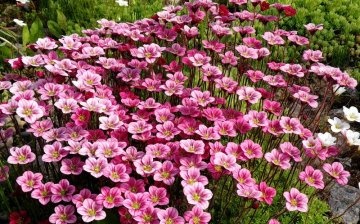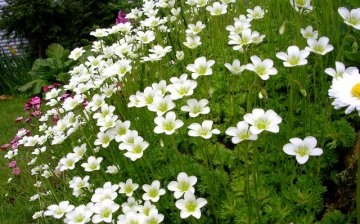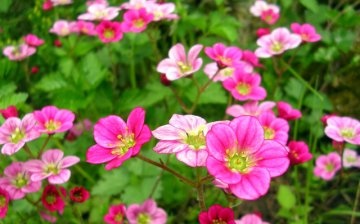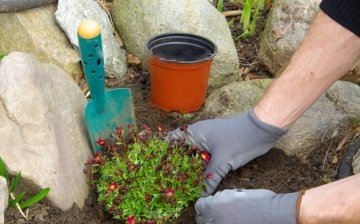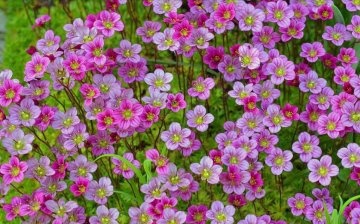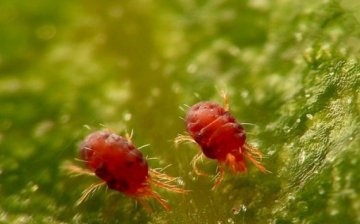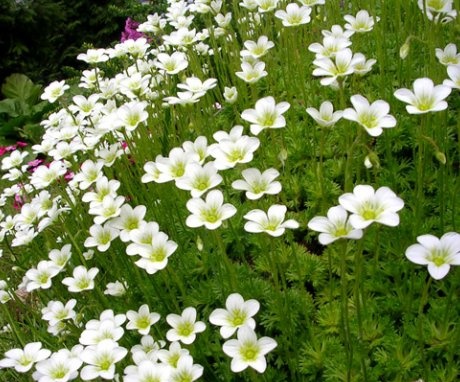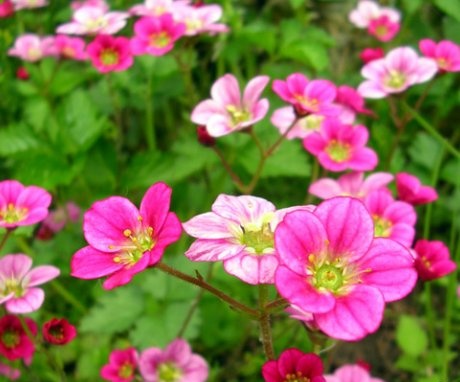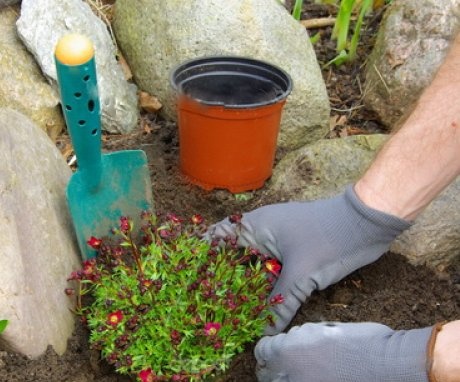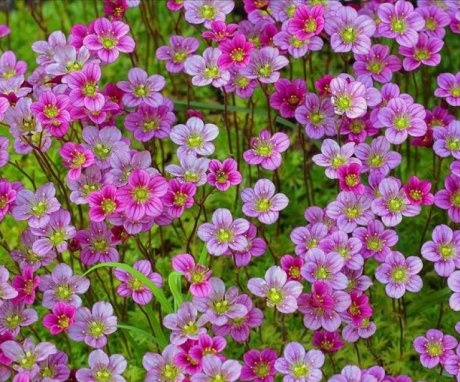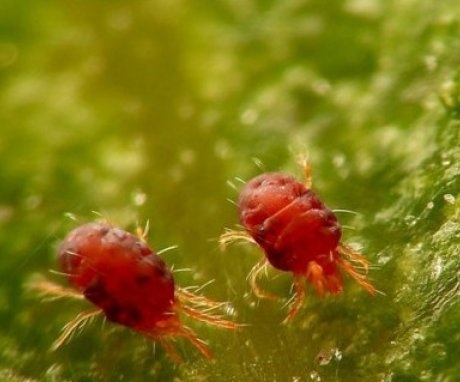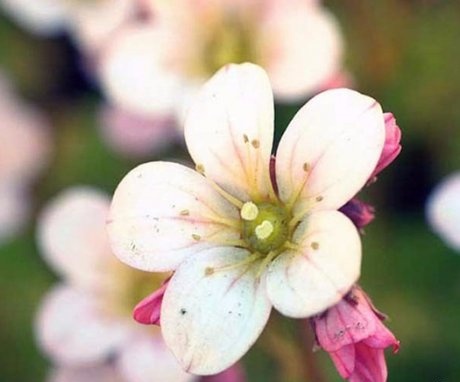Arends' saxifrage - a gentle and graceful plant in the garden
Arends's saxifrage is an attractive and undemanding plant that is widely used in the design of garden plots, flower beds, and alpine slides. Such features as unpretentiousness, frost resistance and, of course, an elegant and interesting look made it so attractive to the gardener.
Content:
- Description of the plant
- Reproduction and planting of Arends saxifrage
- Features of caring for saxifrage
- Perennial diseases and pests
- The use of saxifrage in landscaping a personal plot
Description of the plant
Saxifrage Is a perennial. She is able to grow and delight the grower with her lush green carpet for several years. Saxifrage grows in the northern hemisphere on rocky soils. The ability to grow on stones, in cracks in rocks, on mountain slopes is reflected in the name of this plant.
For the first time, the German breeder Georg Arends introduced the saxifrage into the culture. Therefore, at first the plant was called "Arends hybrid", and then it was given its modern name. Today, Arends's saxifrage means a whole collection of various varieties that differ in appearance, size, and color of the petals.
Planting saxifrage is an elegant carpet of small bushes with green leaves with a silvery sheen. The leaves are collected at the root in small rosettes. Depending on what sort of saxifrage is planted on the site, the height of the stems can be up to 20 cm. The saxifrage grows rapidly. Rosettes of openwork leaves form fluffy mounds. Outwardly, Arends' saxifrage resembles moss shoots. The leaves of the rosette die off every year at the bottom, and new foliage appears at the tops, so the shoots can be brown at the root and green at the tops. But in the period flowering the appearance of the plant changes greatly. The flowers of Arends' saxifrage have five petals.
Twenty-centimeter flower stalks appear over the carpet of green leaves, and the saxifrage clumps are covered with a carpet of white, pink or red flowers.
A blooming saxifrage will delight the eye for a whole month, and then fruits will form on the peduncles. However, red flowers are not as common as white or pink flowers. The dependence of the color of the petals on the height above sea level of the place where the flower grows has been noticed. The higher the area where the saxifrage is planted, the brighter and richer the color of the flowers will be.
The saxifrage blooms for about a month. Depending on the variety, the flowering period can be any time between May and August. Arends' saxifrage flowers are pollinated by insects. The fruits of this plant are capsules in which many small black seeds are hidden.
Landscape designers know many varieties of Arends saxifrage, bred by breeders over more than a hundred years of using this plant. Here are some of the varieties and hybrids in use today:
- Purplemantel. The characteristic features of this variety are the relatively high plant growth and the bright purple-pink color of the petals.
- Blutenteppich. Plants of this variety are lower, flowers are bright red.
- Schneeteppich. This variety has very decorative flowers.They look like small white stars and look very advantageous against the background of velvety green leaves.
- Flamingo. This saxifrage reaches 15 centimeters in height. Flowers of the "Flamingo" variety are pale pink.
Reproduction and planting of Arends saxifrage
There are two ways to propagate Arends' saxifrage:
- By dividing the plant into parts. This method is also good because the plant rejuvenates when seated and gets rid of the appearance defects inherent in old bushes.
- Growing a plant from seed... Saxifrage gives a lot of seeds, so gardeners also choose this method quite often.
By dividing the bush saxifrage can be propagated only after flowering has stopped. Rosettes of leaves are carefully separated from the main bush entirely, and then rooted into the soil. Newly transplanted plants need to be protected from the scorching rays of the sun, they are very dangerous for the young clump. By the next spring, young saxifrage will get stronger, and you can put them in a permanent place.
The main feature of the reproduction of saxifrage by seeds is the need to treat the seeds with cold before planting.
For this, small black seeds of saxifrage are sprinkled on a small layer of well-moistened soil. After that, the container with seeds is kept in the refrigerator for a couple of weeks, and then on the windowsill, covered with a film on top. Germinate seeds better at around 20 ° C. After a week, the first seedlings should already appear in the seed box. Saxifrage plants, just sprouted from seeds, have very weak and delicate leaves. Better not to rush with dive seedlings, and wait for the first strong leaves to appear.
Seedlings saxifrage can be planted in early summer, in the first week of June. Individual bushes are planted at a distance of about 10 centimeters. Feed the plant stands a week after transplanting. The saxifrage also enjoys loosening the soil and weeding. The first flowers on planted plants can be expected only in the second year of life.
Features of caring for saxifrage
Arends' saxifrage is a rather unpretentious representative of the plant world, but loves such conditions for growth:
- The only essential requirement is soil moisture. The saxifrage needs moderately moist soil. If the soil dries up, the plant may even die. If, nevertheless, there was a period of drought, then the plant needs spray leaves. This will help give the saxifrage its smart green appearance.
- Saxifrage is a winter-hardy plant. The optimum air temperature for saxifrage is 20 ° C, higher temperatures can cause disease or kill plants. In gardens, the saxifrage prefers shady places where it is protected from the scorching sun. This should be taken into account when placing a flower garden. When growing in pots in winter, you need to ensure that the plant temperature drops by 5-10 degrees. Saxifrage seeds need cold treatment for proper germination.
- The lighting requirements for Arends' saxifrage are not too demanding. The plant prefers partial shade, but it also tolerates direct sunlight well. It is undesirable only to allow complete shading for a long time.
- For saxifrage, light soils, sandy or sandy loam, are best suited. Plants in natural conditions grow on stony slopes, therefore, when growing, saxifrage also tolerates stony soil well. The presence of limestone in the soil has a beneficial effect on the well-being of the saxifrage.
- There is a need for soil fertility. But it is not advisable to get carried away with fertilizers - with an excess of fertilizers, the sod becomes loose and will suffer from pests and diseases... Superphosphate or bone meal are good fertilizers, but nitrogen fertilizers should be avoided. Only nitrogen is allowed fertilizers as part of a complete top dressing.
- The saxifrage needs fertile soil, and most importantly, the soil must be well drained. Conditions that mimic natural conditions are best suited for the plant: an inclined rocky slope, along which excess moisture will drain from the roots without causing damage to them.
- Lack of moisture can also have a negative effect on the appearance of the saxifrage. If there was little moisture during the flowering period, black bald spots may appear in the curtain of the plant, which greatly spoil the appearance. They are able to overgrow themselves, but after that, spots that differ in shade appear in the green half of the saxifrage leaves. To avoid this, you can plant young plants in the largest holes. Saxifrage grows quite quickly, so a green carpet with your help will quickly close the holes. And, of course, it is worth taking care of sufficient watering.
- To maintain decorativeness after flowering, you need to remove old peduncles. To do this, they wait for the old flower stalks to dry up, and then break them off at the base. If this is not done, dried shoots will greatly spoil the appearance of the bush. Over time, the appearance of the saxifrage bush deteriorates, old shoots turn brown and lose leaves. To avoid this, it is worth replanting the plant every five years, rejuvenating it.
Perennial diseases and pests
The saxifrage does not often suffer from pests or diseases. This is a fairly stable and unpretentious plant. But improper care, mistakes in watering and feeding regimes can make the plant vulnerable to parasites or infections. In this part of the article, we will talk about the main diseases and pests that a florist may encounter, as well as how to protect Arends' saxifrage from them.
The most dangerous pests for saxifrage:
- Spider mite. This pest attacks plants weakened by drought. Ticks entangle the saxifrage clumps with whitish cobwebs. Another sign that a tick has started up on the saxifrage is the appearance of yellow spots on the leaves. The leaves affected by the mite dry up and gradually die.
- Green aphid. A sign of aphids on the plant is the formation of a sticky black bloom on the stems and leaves. A good method of dealing with aphids - the use of anti-sweat preparations, such as the Pirimor insecticide.
- Scorms. You can fight worms by collecting them with your hands or with tweezers from plants. A good result is given by special anti-coccid formulations.
- Thrips are small insects that eat flowers and green shoots of plants. Small, colorless spots appear on leaves affected by thrips. To combat thrips, insecticides are used, but you can try to do with folk remedies - infusion of pepper, tobacco or other similar compounds.
Arends' saxifrage diseases are associated with waterlogging. From constant moistening of the leaves and air on the plant, fungi can develop, which will lead to the development of diseases such as:
- Cercosporella fungi cause stains on the leaves. You can remove the fungus by treating the leaves with a preparation containing copper.
- Powdery mildew... This fungal disease is manifested by the appearance of a whitish bloom on the foliage, which looks like flour. To combat powdery mildew, fungicides are used, for example, "Nitrafen". It is better to remove the affected leaves.
- Rust is the result of the development of a rust fungus on the plant. To combat it, a solution of soap and copper sulfate is used.
- Decay of roots. The reason is excessive watering and poor drainage of the soil, which leads to stagnation of water at the roots. If the roots have begun to rot, you need to dig out the whole bush and carefully examine it. Decayed parts should be separated and then destroyed, and whole rosettes with intact shoots and roots should be planted again. To protect against fungi, the plant should be treated before planting. fungicidal agents.
The use of saxifrage in landscaping a personal plot
Modern solutions in landscape design are often built using Arends' saxifrage. High decorativeness and unpretentiousness of this plant made it the favorite tool of the landscape designer. Saxifrage looks very advantageous in rock gardens, on artificial embankments, in design elements that imitate rocky slopes. Luscious lush green saxifrage and bright, abundant flowers transform an empty garden area. A place where no other plants will grow, saxifrage clumps can turn into a beautiful flower garden.
The attractiveness of saxifrage for use in landscaping is enhanced by the good compatibility of saxifrage with many other garden flowers.
Irises, muscari and other flowers with a small stem height can form picturesque flower beds with the saxifrage. Also Anders' saxifrage goes well with decorated gentian and lingonberry.
In addition to outdoor flower beds, saxifrage can be grown as a houseplant. It grows well in pots, looks beautiful on window sills and in hanging pots. It is not difficult to grow a saxifrage. This beautiful and unpretentious plant grows well and will thank the grower for taking care of a bright floral carpet.
More information can be found in the video:



